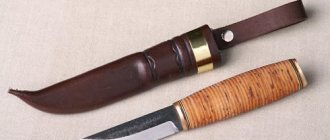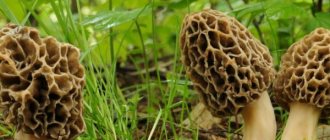Types of perennial
The brown plush heads of the plant are visible from afar. They attract attention with their unusualness and beauty. The first description of cattail is found in the works of the ancient Greek naturalist Dioscorides, who gave it the name “Turk” .
It is called stick insect, devil's grass and barrel grass. The latter name is due to the fact that coopers used its leaves in the manufacture of barrels.
Not everyone knows where cattail grows and in what zone. The best conditions for it are in temperate and tropical climates. There are about thirty species of this plant. The most common:
- broadleaf;
- narrow-leaved;
- small;
- Caspian;
- ivory;
- Dominican;
- Oriental.
Cattail and reed - differences photos
So, having considered both characteristics, we can summarize how exactly both cultures differ:
- belong to different families (cattails - cattails, reeds - sedges);
- have different arrangements of leaves (in cattail they grow on the stem, in reeds they grow separately);
- form different inflorescences (rocker - for cattail, panicle - for reeds).
And one more important fact. A lover of swamps, cattail itself contributes to the pollution of water bodies, and reeds reduce it.
Cattails in Russia
In our country, the most common are narrow-leaved and broad-leaved cattails.
Favorable places for its growth are the shores of shallow bodies of standing water, such as swamps, ditches, roadsides, puddles and lake shores. It also thrives in polluted waters. It, like sedge and reeds, perfectly purifies water, destroying dangerous substances.
The thickness of the broadleaf cattail root is 2−3 cm and the length is 50−60 cm. Every year the rhizome produces new shoots. The thick stem grows up to two meters. Inside the long, hard leaves are tubes through which air flows to the flooded parts. The leaves reach three meters in length and their width is approximately 2 cm.
A distinctive feature of the cattail plant is its cylindrical inflorescence (cob) of dark brown color. It contains female (pistillate) flowers. And on the pointed process there are male (staminate) flowers.
Broadleaf cattail blooms in June and early July. The wind carries pollen from male flowers to female flowers. Pollination occurs, after which the male flowers dry up.
August is the time of fruit ripening. The surface of the cob, which contains the fruits (seeds), is velvety and elastic to the touch. But if you open it, you can see white fluff inside.
In late autumn, the leaves and stems dry out. And the fruits remain on the cob, as before. At the beginning of spring, they crumble and are carried by wind and water.
Once in the water, the fruits float until they are completely wet. They then drown to germinate and give birth to new plants. The root system forms very extensive thickets in the reservoir.
Narrow-leaved and broad-leaved cattails are very similar. The difference between narrow-leaved is the small width of the leaf (1 cm) and the small size of the plant itself. Its cobs are much thinner and look like pencils. But what’s interesting is that the rhizome of the narrow-leaved cattail is massive and thick.
Small cattails are grown for decorative purposes. Elegant, thin-leaved, with small ears, it looks good in small artificial reservoirs. You can easily grow it yourself in a special container or in a regular trough.
Description
The thick, cylindrical stem with no nodes grows up to 3m in height.
Cattail leaves are gray-green in color, 4 cm wide. They exceed the height of the stem. They have a long, linear shape. Their growth begins from below, from the rhizome. The base of the cattail leaf is in water (see photo of the plant).
The rhizome is thick, creeping, with white filamentous tufts. The upper part of the thin roots grows upward and absorbs water and nutrients, while the lower thick roots sink into the mud and hold the position of the stem. The rhizome along with the stem is easily removed because it is located in a muddy and muddy layer.
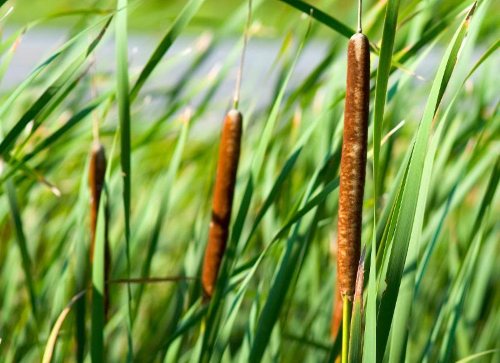
Cattail in the swamp
The flowering period occurs in the last week of June and the beginning of July. Small unisexual male flowers are located at the apex. A dense cylindrical inflorescence with a diameter of 2-3 cm from female pistils of dark brown color looks like a rocking chair up to 25 cm long. Pollination occurs by the wind. At the end of summer the seeds ripen.
The seeds are located in the middle of the cob on fluff. Gusts of wind tear apart the ripe cob and scatter the seeds. At first, the seeds float on the surface of the reservoir, and when wet they descend to the bottom, where they germinate.
Among the 20 plant species, narrow-leaved and broad-leaved cattails are more common , which can be distinguished in the photo of the plant.
In the narrow-leaved plant, the cobs are pencil-like, thin and not so long. Plant height is limited to 1-1.5 m.
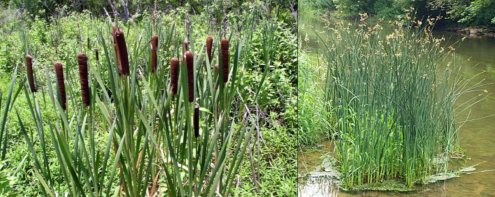
Cattail and reeds
Small cattails are planted in home ponds. It grows only 45-60 cm. It is a reduced decorative copy of its fellows.
Use in food
The roots of the plant contain starch, protein, fat, sugar, fiber, minerals and vitamins. It can become a tasty and healthy food for vitamin deficiency, fatigue, and low hemoglobin levels. Food prepared from it is indispensable during a long hike.
The leaves (at the base of the stem) of young cattail taste like a cucumber. You can make salads and soups from them. The roots, charcoal-roasted or boiled, resemble potatoes. They can be made into flour and used to make flatbreads.
From crushed roasted roots you can make a drink similar to coffee .
Boiled young shoots taste like asparagus. They are also used in pickled form.
Cattail plant: types for decorating areas
Among all the cattails, there are several main species that grow in different regions of the planet. Usually these are typical coastal aquatic plants, preferring muddy and muddy-sandy shores, protected from breakwater. On rocky soils, low, sparse communities are most often found.
Cattail is a plant of water bodies, so it is used to decorate garden landscapes near streams and artificial waterfalls.
Suitable for these purposes:
- Angustifolia cattail is a plant with oblong-linear leaves collected at the base of the stem, less than 1 cm wide. It needs nutritious clay soil. In cool summers it does not always form cobs. In addition to the Northern Hemisphere, it grows in southern Africa and Australia.
- Broadleaf cattail is common in the Northern Hemisphere. It differs from other species in having thicker and taller stems. The diameter of the inflorescence, velvety to the touch, is about 2.5 cm. The brown ears are very decorative, and only in the spring they begin to disintegrate into individual seeds. Grows in acidic, marshy soils.
- Cattail Laxmana - prefers well-moistened areas near rivers and lakes. Found in the steppe zone and subtropics. There is a lot of it in the Caucasus, the Far East, Siberia, Mongolia and China. Plant height is on average from 60 to 90 cm, maximum - 130 cm. The leaves are gray-green, narrow. The cobs are brown.
- Small cattail - grows in marshy areas of Western Europe, as well as in Central Asia, China, Mongolia, Turkey, and is found in the Caucasus. This is a low and very graceful plant with thin leaves. The pistillate part of the inflorescence is brown in color and widens towards the apex.
Also in demand for landscaping swamp areas of small private ponds are small cattail, whose height is only 30–60 cm, and graceful cattail. These compact plants look great in winter and are incredibly beautiful in bouquets and ekibans, but cannot withstand severe frosts. In the fall, they are placed in containers and transferred to a cold basement.
In good conditions, cattail behaves aggressively - it is capable of capturing a large territory in a short time. Therefore, it is better to plant several plants on the site in containers or in geogrid bags.
Healing properties
The leaves, roots, cobs and flowers of this plant are used in folk medicine. Leaves should be harvested in June and July, and roots in August and September. The cobs must be collected before frost sets in.
During a hiking trip or fishing, crushed leaves are indispensable as a hemostatic and healing agent for fresh wounds, from which no one is safe in camping conditions.
A decoction prepared from the leaves normalizes the glucose level in the blood.
Medicines made from it are excellent for many diseases:
- flowers and cobs are used for intestinal, gastric and hemorrhoidal bleeding, as well as for urethritis, cystitis and gynecological diseases;
- frostbitten and burned areas of the body are smeared with melted butter mixed with cob fluff;
- for dysentery, an infusion of leaves is used as an astringent;
- bleeding wounds are sprinkled with powder made from inflorescences.
The only contraindication to treatment with cattail medications can be individual intolerance.
Where do cattails usually grow?
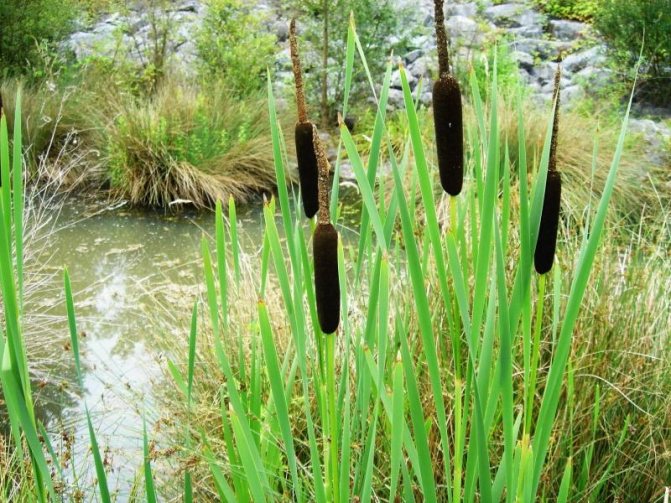
Herbaceous perennials, with thick and branched rhizomes located horizontally, thrive on the banks of reservoirs and shallow waters, in damp ditches, and roadside ditches. And thin roots create floating turf. Any pond or lake of natural origin will eventually become overgrown with these unpretentious plants, the height of which can reach 2 m.
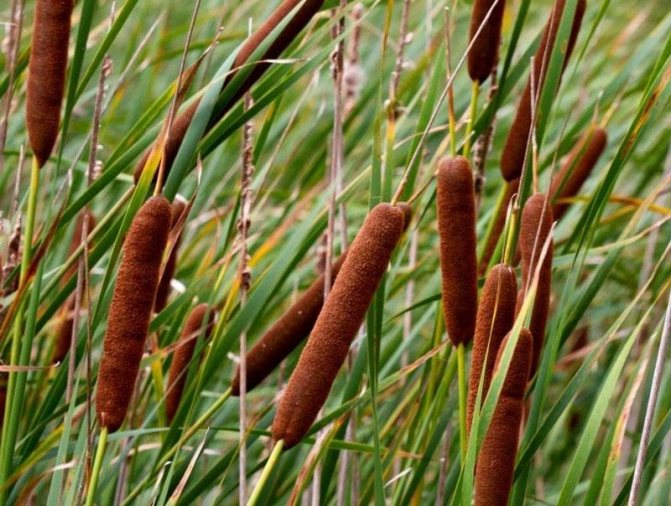
Most cattails are found in southern Eurasia and North America. Different species require areas with rich, acidic or saline soils that receive good sunlight throughout the day. During the growing season, thanks to powerful rhizomes, cattails form dense thickets. Despite the fact that plants do not respond to fluctuations in water levels in reservoirs, reproduction occurs best if the depth is 60–90 cm.
Cattails are propagated, if necessary, by dividing the roots. This is the simplest and most successful method of creating an entire colony of plants that will protect neighboring plants, such as water lilies, from strong winds. In addition, cattails are natural filters. And their plantings are like a natural wastewater treatment plant!
Application for construction and economic purposes
Since ancient times, people have appreciated not only the nutritional and medicinal value of cattail. It was widely used in the household, in the manufacture of matting, shoes, bags, and rugs. Cob fluff was used to stuff mattresses, pillows, furniture and even life jackets. Cobs soaked in oil successfully replaced torches.
Nowadays it is not forgotten and is also successfully used.
- The dry plant replaces fuel in areas where there is little forest.
- The leaves and stems are used to make baskets, hats, wicker furniture and all kinds of crafts.
- It is used to make paper, packaging material, and canes.
- The stems are used as building material.
Many people use it to decorate their homes, making wonderful bouquets from it. Of course, they don’t last long indoors, since the cob crumbles as it ripens.
Harm from cattail.
the roots in food with caution for people suffering from constipation and excess weight .
Otherwise - only personal intolerance , for example, an allergy to fluff - pollen. Therefore, only personal experience. Try it a little and if your health does not worsen, then consume it.
The main danger is to confuse it with another cattail-like plant , in which case it is possible to get poisoned.
Before the typical cattail seed heads are visible, it can be confused with the iris. Irises grow in the same areas, but are toxic and therefore not edible. The main difference between cattail and iris is determined by the stem; here the leaves grow around a round stem at its base. Iris leaves grow around a flat stem at the base. By the way, there is a parable about irises and cattails.
To prevent you from getting confused in the plants, see the picture below. It shows characteristic differences, for example, cattails and reeds (if you don’t see something, zoom in).
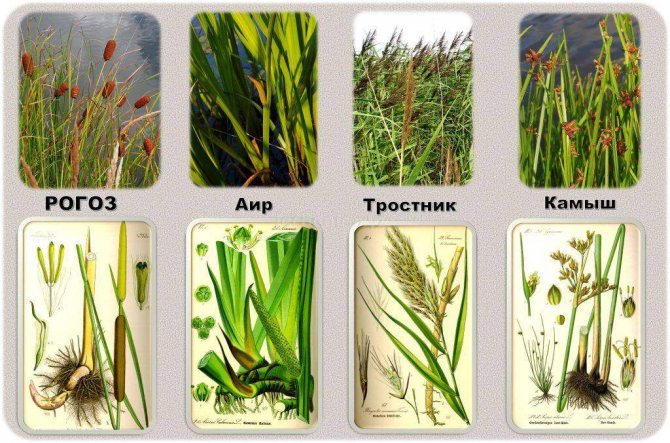
Tags: vitamin deficiency, tonsillitis, anemia, vitamin C, dermatitis, dysentery, colitis, hemostatic, diuretic, periodontal disease, fatigue, wound healing, wounds, cattails, type 2 diabetes mellitus, weakness, stomatitis, scurvy
- Related Posts
- Treatment with burdock oil.
- Milk thistle - medicinal properties.
- Rosemary essential oil properties.
« Previous entry
